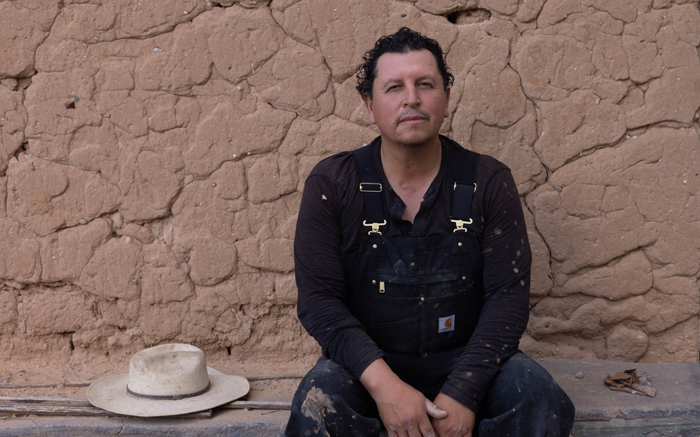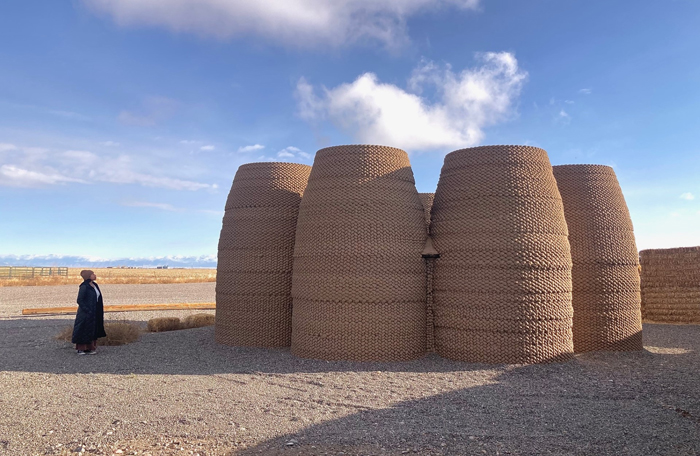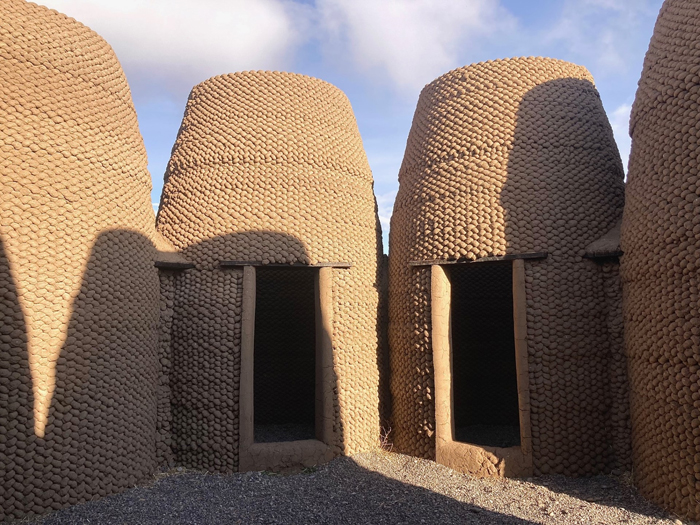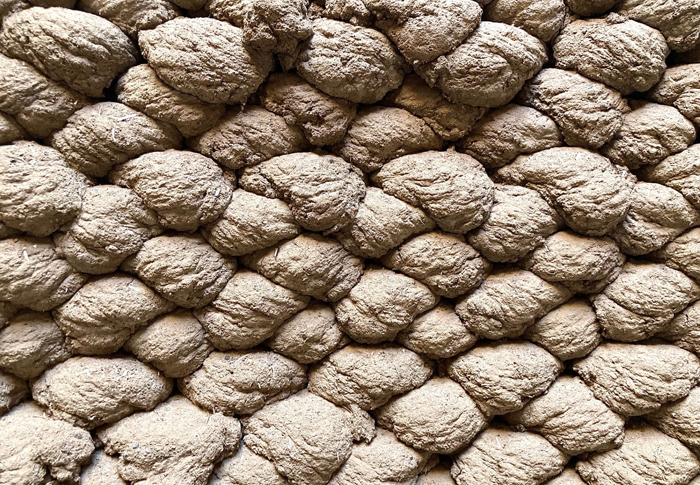Ronald Rael, who was born and raised in the San Luis Valley, harnesses the inherent contradictions between heritage and digital-build practices in his 3D-printed adobe works.

In her seminal work of hybrid literature Borderlands/La Frontera: The New Mestiza, Gloria Anzaldúa defines the borderlands as a contested zone where “two or more cultures edge each other, where people of different races occupy the same territory, where under, lower, middle, and upper classes touch, where the space between two individuals shrinks with intimacy.”
The language of “touch” and “intimacy” certainly suggest a sensual and emotionally open space; and the notion that borderlands “shrink” the distance between culture, race, and class—no doubt—gestures toward a diverse and multi-faceted experience. Indeed, Anzaldúa articulated “certain joys” and an “exhilaration” found within and along the borderlands, which contributes to the “further evolution of humankind” via the intermingling of disparate groups.
But she most definitely did not envision the borderlands through a utopian lens of harmonious companionship or mutual understanding. Rather, the late Anzaldúa knew firsthand that these regions were “not a comfortable territory to live in.” They were, in fact, riddled with “contradictions,” resulting in “hatred, anger, and exploitation.” This “vague and undetermined place” is, as she poetically puts it, “una herida abierta where the Third World grates against the first and bleeds. And before a scab forms it hemorrhages again, the lifeblood of two worlds merging to form a third country—a border culture.”
While speaking over Zoom with the architect, artist, author, entrepreneur, CEO and co-founder of the 3D-printing company Emerging Objects, and University of California, Berkeley educator Ronald Rael, he vocalized similar sentiments about the region. Of the San Luis Valley, which encompasses south-central Colorado and far north-central New Mexico, he says, “Its history is interesting to me because of the post-Mexican-American War drama that unfolds there. It’s where Mexico and the United States, the Colorado, Mexican, and Native American territories come together. And,” he adds, “it happens to be where my family has lived for about seven generations. We’re intimately connected to that landscape.”
Further echoing Anzaldúa, Rael mentions that “the scars of the borderlands still exist” in the San Luis Valley. “A lot of what I’ve been doing for most of my life—and it’s resulted in outcomes that are more design and art-based during the last ten to fifteen years—is related to digging deeply into its history. Because it’s not something offered to the people who are from that landscape. There’s a tragic erasure that has happened, and I’m trying to uncover that story and share it. Because it’s an important story: a story of who we are as a people and the place itself.”

But what, exactly, has Rael been working on as it relates to art, design, and the excavation of buried narratives? The answer—as one might expect from a man who was born and raised in a borderland region fraught with complexity, contradiction, and ambiguity—is in no way singular.
“My father was a builder,” Rael recalls, “so I was on building sites since I was very young.” Not only did his father construct and remodel most of these homes from earthen architecture, but Rael also notes that “I still live in the house my great-grandfather built, which is a humble adobe house in the village where my mother’s family is from.” His investment in building, particularly with adobe, led Rael to pursue a degree in architecture from Columbia University in New York City—a far cry from the high desert of the San Luis Valley. One can imagine that the juxtaposition of East Coast urban life and rural, high-desert life of the Southwest produced within Rael a certain psychic and cultural borderlands.
“Columbia has the best architectural library in the world,” Rael mentions, “so I was diving into the archives on earthen architecture. I went beyond what I knew from my region in Northern New Mexico and the San Luis Valley, and into Africa, China, and all continents, really. There’s this amazing global tradition that’s more than 10,000 years old of humans building with earth in innovative ways.”
Of course, Rael is quick to note that he’s “not a Luddite,” and his curiosity does not conclude with pre-modern building traditions. “I’m interested in technology,” he says, “but mostly in the confluence of technologies that make sense.” While at Columbia, Rael’s department was “the very first school to have a paperless studio. I was learning digital modeling techniques and computer control, which enabled me to work with 3D printing.” Specifically, he wanted to explore the possibility of using 3D printers with earth to create adobe structures. This convergence of pre-modern and contemporary building techniques, indeed, epitomizes an architectural borderland.
In order to develop a technique for 3D printing adobe, Rael studied the work of Behrokh Khoshnevis, an Iran-born professor at the University of Southern California whose proprietary Contour Crafting process leveraged rapid additive prototyping methods that translate computer models into large-scale, physical objects. “He was trying to print with concrete,” Rael says, “But because he didn’t want the machine to get stuck with concrete—which was completely experimental at that time—he was using clay. He never talked about clay being the end goal, he was just using it as a filler material while perfecting concrete.” Khoshnevis’s use of clay, though, offered Rael a technological and material entryway into his dream of 3D printing with adobe.

But before he could begin work on his inhabitable structures, Rael knew he would have to perfect his building algorithms on smaller objects. “Around 2016 or 2017,” he recounts, “I started making ceramics that used the same algorithm that would allow me to print things at large scale.” The textural patterns that Rael developed with computer-based design algorithms resulted in corrugations that snaked and twisted; thus, creating a complex woven surface on the objects he fabricated.
“All those ceramics were studies for how to work at large scale,” Rael says. “I imagined weaving the earth back-and-forth [in a similar fashion] because the corrugation gives an object strength. Likewise, I imagined how those patterns could give earthen architecture a new kind of aesthetic [outside a traditional, Southwestern visual idiom]. So the studies were structural, but also aesthetic.”
Although he viewed these ceramic outputs as experiments for future architectures, Rael recalls that “something beautiful” happened with these test objects. “[Since] my studio [Emerging Objects] was the first in the world to make these weird textures on clay,” the novelty of the objects started “getting so much attention and launched me into the world of ceramics. I didn’t consider myself a ceramicist, but I was able to travel all over the world, showing them off. It started a movement: now it’s common, and people are building upon this research.”
With much of his initial research complete, Rael teamed up with an industrial manufacturer to create a robotic arm that could print with adobe. “I made a schematic design and showed it to him. We built that first robot around 2018. The tool was about the size of my body and had an eight-foot diameter reach.”
One of the more prominent structures fabricated with this first robotic tool is the Skylos (2022), located at the Frontier Drive-Inn outside of Center, Colorado, in the San Luis Valley. The Skylos is a series of eight abutting vase-like dwellings constructed of a corrugated pattern similar to those that Rael’s ceramics employed.

“The folks at Frontier Drive-Inn had seen Casa Covida,” an earlier version (from 2020) of the Skylos concept that Rael constructed on his private property, “and came out to visit,” Rael remembers. “They were interested in this Land Art, and I imagined a scenario in which I could make a whole courtyard based on those structures.” Not long after, he began fabricating what would become the Skylos project.
Rael named the structures Skylos due to the preponderance of silos in the northern part of the San Luis Valley. He understands them as “silos for holding sky and the relationship they develop between earth and sky. I love photographs [of the overhead viewing portal] where there are clouds. The framing of it looks like the planet Earth.”
“It’s this beautiful meditation about the sky, the land, and the Earth,” Rael continues, “and the idea that these were monastic chambers for enjoying the sky and the coolness of the air—it’s quite simple in a way. And it allowed me to experiment with legitimizing the building material in a way that’s responsive to building codes. It’s probably the first permitted, 3D-printed earthen building on the planet. I also think it’s the largest 3D-printed earthen building on the planet.”
Rael, though, conceptualizes Skylos and much of his output as works in progress: templates for more advanced, intricate, and larger objects. “These are experiments. If I were making architecture, I would put a roof over it. But these are about the sky being the roof… to me, like a lot of the things I do, it’s less about a finished product as it is a demonstration.”
A finished aesthetic product, a process experiment, or a material and technological demonstration? Rael’s artworks and architecture are all of these things simultaneously. His practice exists at the borderlands, where rigid categorization melts away, just as unattended adobe structures melt back into the earth from which they came.
Rael, it seems, would agree. “It pushes me across these boundaries of art and architecture. I’m interested in architecture, but I’ve fueled my research through the lens of art. Skylos is a blurring of these two fields. It’s clearly an inhabitable sculpture, but it follows many of the rules of architecture.”
Or, in the words of Gloria Anzaldúa, Rael’s practice “operates in a pluralistic mode—nothing is thrust out… nothing is rejected, nothing abandoned. Not only does [it] sustain contradictions, [it] turns the ambivalence into something else.” And that something else, which his practice embraces, is the Mud Futures project, where heritage building meets digital design, where architecture meets art, where, as Anzaldúa says, “The straddling of two or more cultures… creates a new consciousness.”






